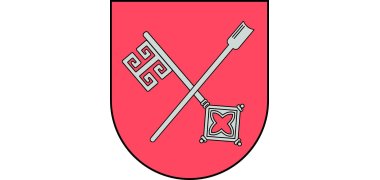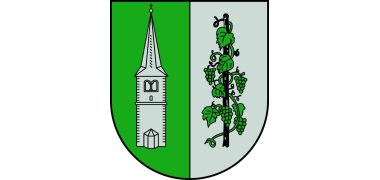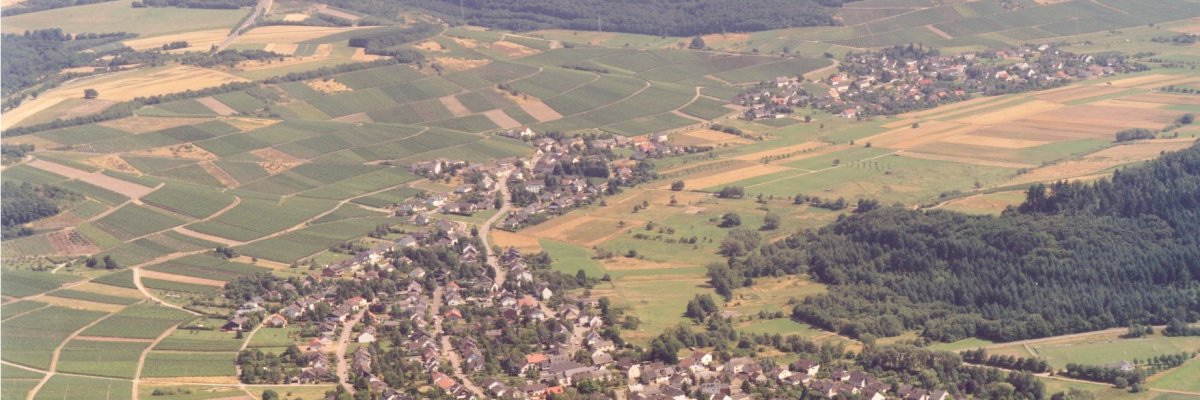District Mennig (Tälchen)
In the "Konzer Tälchen", where millions of years ago the waters of the primeval Moselle flowed through the valley, there are now three villages, lined up like pearls on a string: Niedermennig, Obermennig and Krettnach. The three wine villages have certainly retained their own character: in the wide, fertile valley meadows and fields, while on the favorable slopes the vines (mainly Riesling) stretch up to the forest at the top.
It is a gentle landscape, here between the Saar and the Moselle, whose soft lines go just as well with the relaxing tranquility of the small villages as the mild climate of the wine region.
The residents of the three villages feel like one community. And they do a lot together, whether in a sports club, parish, bowling club, women's community, youth group, local history club, area maintenance or in the association of "Tälchen-Winzer".
mennig
Niedermennig, scenically attractive at the entrance to the Konzer valley, 4 km from Konz, is the largest town in the valley. Like the neighboring towns of Obermennig and Krettnach, it is characterized by winegrowing.
Niedermennig was first mentioned in 1329 as menga (probably together with the nearby Obermennig), 1360 is the spelling Niedermennich . Mettlach Abbey owned extensive property in the small town (seven fireplaces are recorded in 1563, three in 1684, and then 75 inhabitants in 1787).
The occupation of the left bank of the Rhine by French revolutionary troops ended the old order. The place was from 1798 to 1814 part of the French Republic (until 1804) and then the French Empire, assigned to the canton of Konz in the Arrondissement of Trier in the Saar department. After Napoleon's defeat, the community came to the Kingdom of Prussia in 1815 based on the agreements made at the Congress of Vienna. The place was assigned to the mayor's office of Konz in the district of Trier in the administrative district of Trier, which in 1822 became part of the newly formed Rhine Province.
The oil mill, located on a reservoir of the Niedermenniger Bach, was built in 1849 and was - with one interruption - in operation until the 1960s. After that, there was a threat of decay until the city of Konz and the Local history and tourist association in Tälchen from 1990 endeavored to restore it and restore it to its original condition.
As a result of the First World War, the entire region belonged to the French part of the Allied occupation of the Rhineland. After the Second World War, Niedermennig was one of the communities in the French occupation zone that was annexed to Saarland in February 1946, but in June 1947 it was also one of the towns in the Saarburg district that were reintegrated and became part of the then newly formed state of Rhineland-Palatinate.
On June 7, 1969, as part of the administrative reform in Rhineland-Palatinate, the municipality of Mennig was formed by merging Krettnach and Niedermennig. On November 7, 1970, Mennig was incorporated into the city of Konz.

Heraldry (Heraldry)
Coat of arms of the municipality of Niedermennig
The coat of arms shows a silver key crossed diagonally in red and a silver shepherd's shovel.
The shepherd's staff is the attribute of the church patron, St. Wendelin. The key commemorates St. Peter, the diocese patron.
alumina
Obermennig is the third place in the Konzer valley that is related in terms of settlement history between the two neighboring towns of Niedermennig and Krettnach. Like Niedermennig, Obermennig was in possession of the manorial system from the Middle Ages to the French Revolution of the Trier Abbey of St. Matthias. The Elector of Trier was also the sovereign here.
The occupation of the left bank of the Rhine by French revolutionary troops ended the old order. The place was from 1798 to 1814 part of the French Republic (until 1804) and then the French Empire, assigned to the canton of Konz in the Arrondissement of Trier in the Saar department.
In 1803 the mill belonging to the abbey was auctioned along with the pond.
After Napoleon's defeat, Krettnach became part of the Kingdom of Prussia in 1815 based on the agreements made at the Congress of Vienna. The place was assigned to the mayoralty of Oberemmel in the district of Trier in the administrative district of Trier, which in 1822 became part of the newly formed Rhine Province. In 1858, the mayor's office, which was already in personal union, was incorporated into the mayor's office in Konz.
As a result of the First World War, the entire region was assigned to the French part of the Allied occupation of the Rhineland. After the Second World War, Krettnach was one of the communities in the French occupation zone that was annexed to Saarland in February 1946, but in June 1947 it was also one of the towns in the Saarburg district that were reintegrated and became part of the then newly formed state of Rhineland-Palatinate.
Krettnach
At a distance of approx. 6 km from the city center in the Konzer valley lies the wine-growing town of Krettnach. The place, first mentioned in 1148 as Cretenach and in 1203 as Crittenach, was administered by the Trier Abbey of St. Matthias in the Middle Ages and in the early modern period. In the Middle Ages, the place was the destination of a ban procession, which included the inhabitants of Konz took part, who then had to be entertained by the inhabitants of Niedermennig on the way back. In the electoral period of Trier, Krettnach belonged to the Saarburg office.
The occupation of the left bank of the Rhine by French revolutionary troops ended the old order. The place was from 1798 to 1814 part of the French Republic (until 1804) and then the French Empire, assigned to the canton of Konz in the Arrondissement of Trier in the Saar department. After Napoleon's defeat, Krettnach became part of the Kingdom of Prussia in 1815 based on the agreements made at the Congress of Vienna. The place was assigned to the mayoralty of Oberemmel in the district of Trier in the administrative district of Trier, which in 1822 became part of the newly formed Rhine Province. In 1858, the mayor's office, which was already in personal union, was incorporated into the mayor's office in Konz.
As a result of the First World War, the entire region was assigned to the French part of the Allied occupation of the Rhineland. After the Second World War, Krettnach was one of the communities in the French occupation zone that was annexed to Saarland in February 1946, but in June 1947 it was also one of the towns in the Saarburg district that were reintegrated and became part of the then newly formed state of Rhineland-Palatinate.
On June 7, 1969, Krettnach and Niedermennig formed the new municipality of Mennig, which was incorporated into the city of Konz on November 7, 1970.

Heraldry (Heraldry)
Coat of arms of the municipality of Krettnach
The coat of arms shows a split shield in green at the front, a silver (white) church tower with a broken, pointed roof, a Romanesque double window with a small porch, and a green vine tendril at the back in silver (white).
The tower is a landmark for the municipality of Krettnach because it dominates the entire valley; the vine tendril symbolizes the winemaker character of the village.
